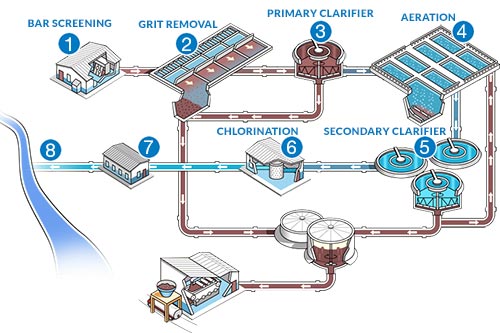Trustworthy Wastewater Options for Green Living and Industry
Trustworthy Wastewater Options for Green Living and Industry
Blog Article
Comprehending Wastewater Treatment Processes and Their Ecological Influence
The ins and outs of wastewater treatment processes play a crucial role in mitigating environmental obstacles associated with water pollution. Each stage, from initial to advanced treatments, is developed to deal with specific contaminants, eventually protecting both public health and wellness and aquatic ecosystems.
Overview of Wastewater Therapy
How is wastewater transformed into a secure source for the atmosphere? Wastewater treatment is a vital process created to remove contaminants from made use of water, thus protecting public wellness and safeguarding ecological communities. This process starts with the collection of wastewater from household, industrial, and commercial resources, which is then guided to treatment centers.
At these centers, different physical, chemical, and biological methods are utilized to treat the wastewater. Initial testing gets rid of huge debris, followed by sedimentation to separate much heavier solids. Ultimately, biological therapies, such as triggered sludge processes, utilize microorganisms to break down raw material. These techniques not just reduce pollutant levels but additionally facilitate the recuperation of beneficial nutrients.
The treated effluent can be safely released right into all-natural water bodies or reused for irrigation and commercial functions, promoting source preservation. Furthermore, the treatment procedure produces biosolids, which can be repurposed as fertilizers or dirt modifications, further enhancing sustainability.
Phases of Therapy Procedures
The wastewater treatment procedure usually includes three primary phases: initial, primary, and secondary treatment. Each stage serves a distinctive role in reducing the contaminant load and making certain the effluent meets ecological standards before discharge.

The primary treatment stage focuses on the physical splitting up of suspended solids from the wastewater. With sedimentation, much heavier fragments resolve at the bottom of sedimentation containers, creating sludge, while lighter materials, such as oils and oils, float to the surface area and are skimmed off. This process dramatically minimizes the natural and inorganic load in the wastewater.
Additional treatment is an organic procedure intended at more reducing the focus of natural issue. This stage is necessary for attaining the essential biochemical oxygen demand (FIGURE) decrease, ultimately leading to cleaner effluent prepared for discharge or additional treatment.

Advanced Treatment Technologies
Adhering to the additional therapy processes, progressed therapy modern technologies play an important duty in additional boosting the top quality of treated wastewater. These technologies are designed to get rid of residual impurities that are not successfully gotten rid of throughout key and additional treatments, guaranteeing the effluent satisfies stringent regulative standards.
Amongst the commonly made use of sophisticated therapy approaches are membrane layer filtering, reverse osmosis, and advanced oxidation processes. Membrane layer filtering, consisting of microfiltration and ultrafiltration, works in separating great particles, pathogens, and colloids from the water (Wastewater). Reverse osmosis utilizes semi-permeable membrane layers to remove dissolved solids, causing high-quality water ideal for different applications
Advanced oxidation procedures (AOPs) use solid oxidants to deteriorate natural contaminants, including drugs and individual treatment products that are immune to conventional therapy. These approaches improve the biodegradability of intricate compounds, promoting their elimination.
An additional substantial modern technology is using biological nutrient elimination procedures, which especially target nitrogen and phosphorus, visit this site preventing eutrophication in receiving water bodies. In general, sophisticated therapy technologies are essential for attaining greater levels of purification, advertising water reuse, and protecting public health while resolving the difficulties connected with wastewater administration.
Ecological Benefits of Therapy
Numerous environmental advantages arise from reliable wastewater therapy procedures that add to ecosystem wellness and sustainability. Largely, these processes significantly lower the release of damaging toxins right into all-natural water bodies, which assists preserve aquatic environments. By getting rid of impurities such as hefty steels, nutrients, and pathogens, dealt with wastewater minimizes the risk of waterborne illness and promotes biodiversity in aquatic atmospheres.
Furthermore, wastewater therapy centers frequently use advanced technologies that make it possible for water recycling and reuse. This method not only preserves freshwater sources yet additionally minimizes the need on all-natural water supplies. Improved nutrient elimination from wastewater can also protect against eutrophication, a procedure that leads to algal blossoms and subsequent oxygen deficiency in aquatic systems.
In addition, efficient therapy procedures can lessen greenhouse gas discharges, especially methane and laughing gas, which are usually released throughout unattended wastewater decomposition. By catching and making use of biogas from anaerobic digesters, centers can transform waste into renewable resource, thereby adding to a decrease in nonrenewable fuel source dependency.
Difficulties and Future Fads
While the environmental benefits of wastewater therapy are clear, numerous challenges linger that impede optimum end results in this area. One major issue is maturing infrastructure, which frequently results in inefficiencies and increased functional costs - Wastewater. Many therapy plants were designed decades back, and their abilities do not align with modern needs, that include stricter regulative criteria and greater quantities of wastewater due to urbanization

Looking ahead, there is a growing focus on source recovery and round economic climate principles within wastewater therapy. Innovations such as anaerobic digestion, which can create biogas, and progressed filtering innovations are getting grip. These methods not only try this website boost therapy effectiveness however additionally advertise sustainability.
Inevitably, dealing with these obstacles needs collaboration amongst stakeholders, investment in innovation, and a commitment to ongoing research. By accepting these patterns, the wastewater therapy industry can develop to satisfy the needs of a changing setting and culture.
Verdict
In final thought, wastewater treatment processes play a crucial role in enhancing ecological high quality and public health and wellness. The multi-stage treatment structure, coupled with innovative technologies, efficiently alleviates contamination and advertises lasting water administration.
Report this page